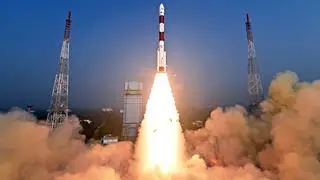ISRO has released pictures that show that the Pragyan rover has been able to avoid falling into a 4-meter-diameter crater towards which it was heading.
When the rover was positioned just 3 meters ahead of the danger, it “was commanded to retrace the path”, ISRO said. This demonstrates the steerability of the rover. If the rover had fallen into the pit, India would have lost about ten days’ worth of experiments that the two instruments onboard the rover could have performed, adding to mankind’s knowledge of science.
(After ten days, that part of the moon will move into the night; the instruments will freeze to death — if they survive and come alive when it is day again, it would be a big bonus.)
Though the primary objective of the Chandrayaan-3 mission is to demonstrate a soft landing on the moon, performing experiments and generating data makes the task much more worthwhile.
The rover houses a ‘laser induced breakdown spectroscope’ (LIBS), which throws a high-energy laser beam onto the moon’s surface, melting that area and creating plasma. In this state, protons, electrons and neutrons are in a soup. As the plasma cools down, the excited atoms return to their lower energy levels; they emit light. The spectroscope captures this light, which analyses the spectral lines to figure out which element reflected the light.
The other instrument is the ‘alpha particle X-ray spectrometer’ (APXS), which contains a small radioactive source that emits alpha particles (two protons and two neutrons). The alpha particles hit the (moon) surface and excite (energise) the atoms. When the atoms return to their original lower energy levels, they emit X-rays captured by the spectrometer. The instrument can identify the element by analysing the X-rays’ energy and intensity.
Thus, both LIBS and APXS are meant to determine a material’s elemental composition — in this case, the lunar surface. The two instruments would have been lost if the rover had toppled into the crater.
Finding ice
On Sunday, the Vikram lander sent a probe 10 cm below the moon’s surface and discovered that the temperature was minus 10 degrees C, while the surface was a little above 55 degrees C.
The surface temperatures can go as high as up to 123 degrees.
Some questions have arisen about how one will find ice there. The answer is that there are craters on the moon whose depths of sunlight never fall because of the moon’s tilt. These craters not only hold ice. The ice, apart from being a source of drinking water and rocket fuel (when split into hydrogen and oxygen), is also a history book — it can reveal a lot about the moon’s past.
Besides, the moon’s axis is just 1.54 degrees to the plane of the moon’s orbit around the earth, which means it stands upright — unlike the earth, whose tilt is 23.5 degrees to the plane of orbit around the sun. Because of this small tilt of the moon, some parts of the south pole — not where the Vikram has landed — are permanently in darkness. They could be holding a sea of ice.







Comments
Comments have to be in English, and in full sentences. They cannot be abusive or personal. Please abide by our community guidelines for posting your comments.
We have migrated to a new commenting platform. If you are already a registered user of TheHindu Businessline and logged in, you may continue to engage with our articles. If you do not have an account please register and login to post comments. Users can access their older comments by logging into their accounts on Vuukle.